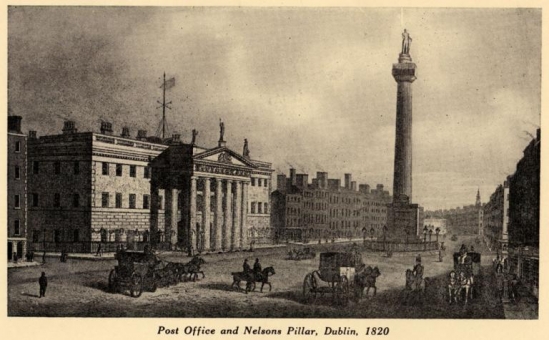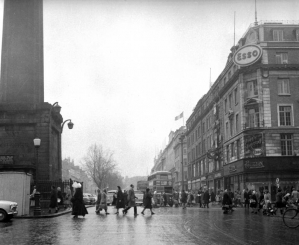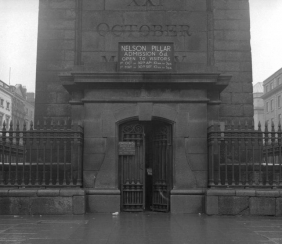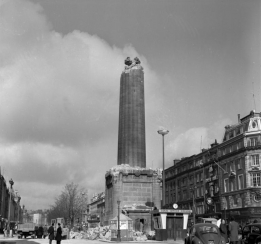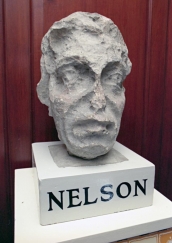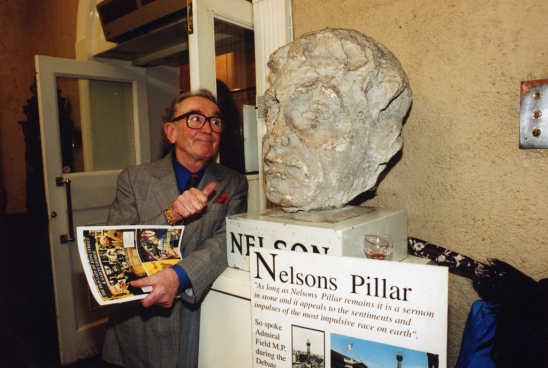#onthisday 1966. Nelson's Pillar Destroyed
Published on 8th March 2016
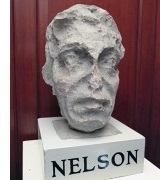 On Tuesday, 8th March 1966, 161 years after the Battle of Trafalgar, at precisely 1:32am, a bomb exploded in O'Connell Street in the heart of Dublin and the statue of Vice-Admiral Horatio Nelson was destroyed. The badly damaged monument had to be entirely removed as a result of the extensive damage. The head of Nelson was recovered, badly damaged but intact, and found a permanent home in the Reading Room of the Dublin City Library and Archive on Pearse Street, where he keeps an eye on the readers researching the history of his native city.
On Tuesday, 8th March 1966, 161 years after the Battle of Trafalgar, at precisely 1:32am, a bomb exploded in O'Connell Street in the heart of Dublin and the statue of Vice-Admiral Horatio Nelson was destroyed. The badly damaged monument had to be entirely removed as a result of the extensive damage. The head of Nelson was recovered, badly damaged but intact, and found a permanent home in the Reading Room of the Dublin City Library and Archive on Pearse Street, where he keeps an eye on the readers researching the history of his native city.
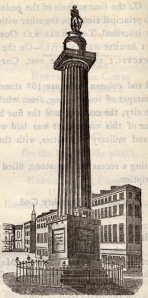 On this, the 50th anniversary of the destruction of Nelson's Pillar, Dublin City Archives are holding a commemorative event at 11.00am entailing a talk by historian Donal Fallon, poetry read by Alastair Smeaton, and songs by Francis Devine.
On this, the 50th anniversary of the destruction of Nelson's Pillar, Dublin City Archives are holding a commemorative event at 11.00am entailing a talk by historian Donal Fallon, poetry read by Alastair Smeaton, and songs by Francis Devine.
The monument was among the first and grandest monuments of its day. Standing approximately 40 meters tall, the pillar dominated O’Connell Street (formally Sackville Street) from 1809 until it was blown up in 1966. Having paid an entry fee, locals and visitors could climb its 168 steps to be offered an unprecedented perspective of Dublin city. After the monument was demolished, Nelson's 'head' was stolen by NCAD students, and used in various fund-raising pranks. It then spent some time in the Civic Museum, before being moved to its present 'resting' place in the Reading Room of the Dublin City Library and Archive.
Left: Engraving: J. Warburton, J. Whitelaw, Robert Wash, History of the City of Dublin, 1818, Vol. 2
The Building of Nelson's Pillar
Soon after the Battle of Trafalgar, 21st October 1805, the Lord Mayor of Dublin, James Vance, convened a group of dignitaries: bankers, nobility, clergy, merchants, etc, to decide one way to honour the memory of Nelson and the Battle of Trafalgar. The choice was to build a monument: a pillar. Initially it was William Wilkins who designed the project, which included a Roman galley on the top of the pillar. Later, the architect Francis Johnston (who also designed the General Post Office, Royal Hibernian Academy, St. George's Church and the Chapel Royal in Dublin Castle) changed the original design placing a statue of Nelson instead of the galley.
Above: Nelson's Pillar Engraving: Individual print
In 1808, the foundation stone for Nelson's Pillar in Dublin's O'Connell Street was laid. The statue was funded by public subscription. The Doric column was 121 feet high, with 168 spiral steps inside, and was topped by a 13-foot high statue in Portland stone of Vice-Admiral Nelson carved by the Cork sculptor Thomas Kirk.
On 21st October 1809, the fourth anniversary of the battle, the Pillar was opened to the public for the first time. For 10d in the beginning and for 6d later, the public could enter the column and go up to contemplate Dublin city from the top.
A porch at street level designed by G.P. Beater was added in 1894.
With the advent of trams, the Pillar became a tram terminus, and a popular meeting place for friends and lovers. "I'll meet you at the Pillar" became a popular saying.
Above Left: Nelson's Pillar, 1960s. Above Right: Pillar Entrance, 1960s
Above Left: Nelson's Pillar, 1966. Above Right: Nelson's head
The site of Nelson's Pillar is now occupied by The Spire.
Above: Nelson's head at its former home in the Civic Museum on South William Street and in the company of the well-loved comedian, Hal Roche, 1999.
These photos are from the Dublin City Photographic Collection. Visit our online Image Galleries.
